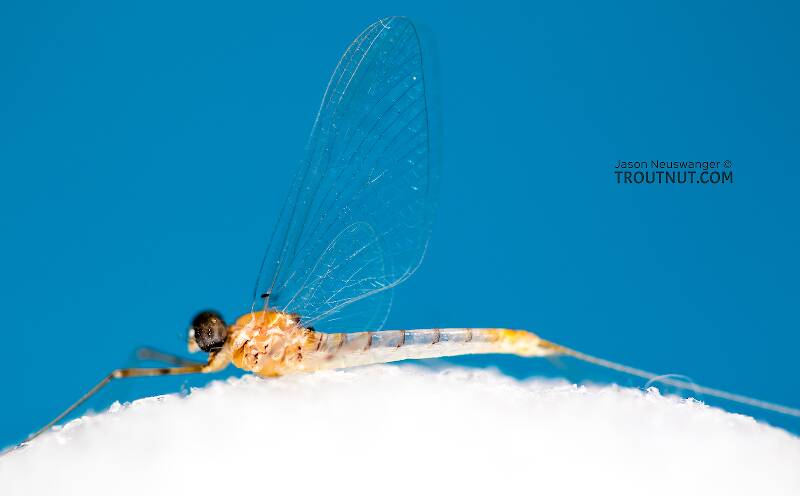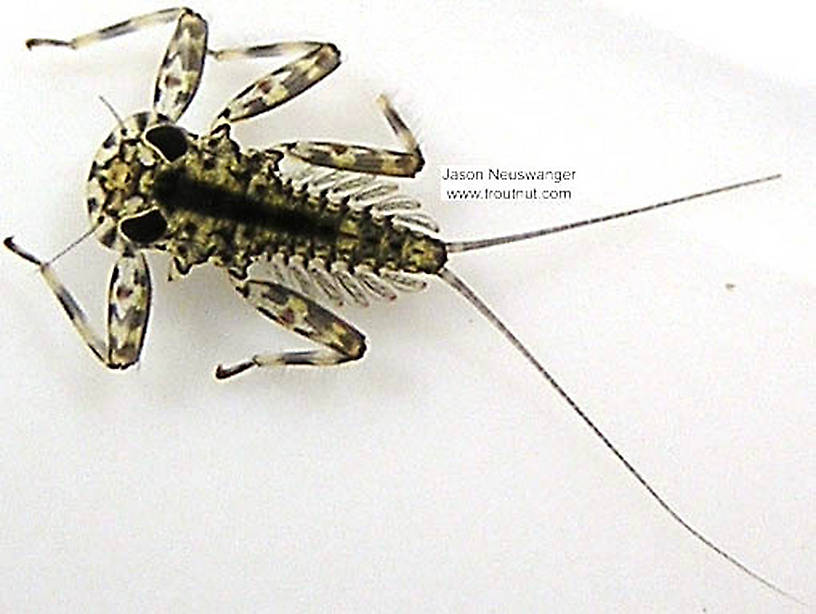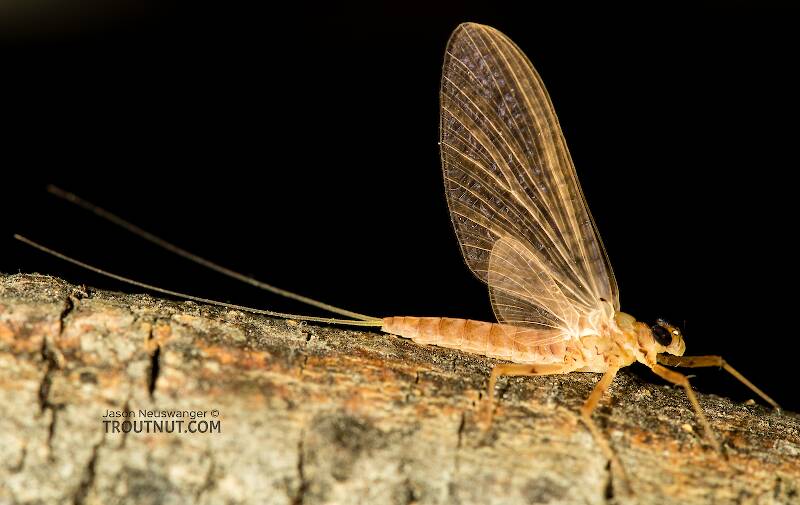
Hex Mayflies
Hexagenia limbata
The famous nocturnal Hex hatch of the Midwest (and a few other lucky locations) stirs to the surface mythically large brown trout that only touch streamers for the rest of the year.
Featured on the forum
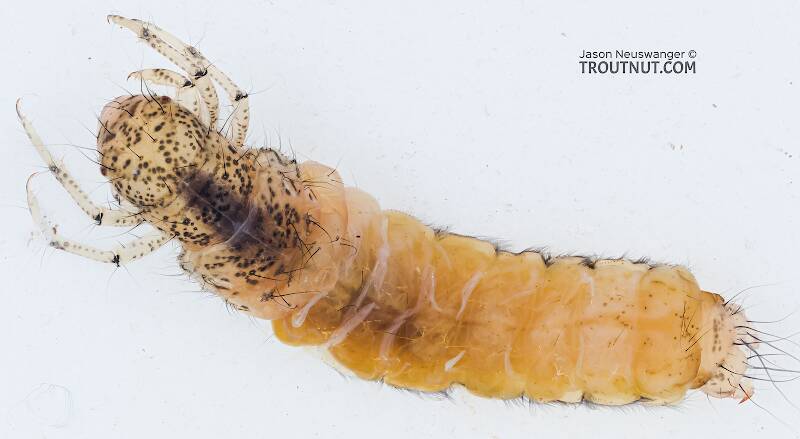
This is a striking caddis larva with an interesting color pattern on the head. Here are some characteristics I was able to see under the microscope, but could not easily expose for a picture:
- The prosternal horn is present.
- The mandible is clearly toothed, not formed into a uniform scraper blade.
- The seems to be only 2 major setae on the ventral edge of the hind femur.
- Chloride epithelia seem to be absent from the dorsal side of any abdominal segments.
Based on these characteristics and the ones more easily visible from the pictures, this seems to be Grammotaulius. The key's description of the case is spot-on: "Case cylindrical, made of longitudinally arranged sedge or similar leaves," as is the description of the markings on the head, "Dorsum of head light brownish yellow with numerous discrete, small, dark spots." The spot pattern on the head is a very good match to figure 19.312 of Merritt R.W., Cummins, K.W., and Berg, M.B. (2019). The species ID is based on Grammotaulius betteni being the only species of this genus known in Washington state.
- The prosternal horn is present.
- The mandible is clearly toothed, not formed into a uniform scraper blade.
- The seems to be only 2 major setae on the ventral edge of the hind femur.
- Chloride epithelia seem to be absent from the dorsal side of any abdominal segments.
Based on these characteristics and the ones more easily visible from the pictures, this seems to be Grammotaulius. The key's description of the case is spot-on: "Case cylindrical, made of longitudinally arranged sedge or similar leaves," as is the description of the markings on the head, "Dorsum of head light brownish yellow with numerous discrete, small, dark spots." The spot pattern on the head is a very good match to figure 19.312 of Merritt R.W., Cummins, K.W., and Berg, M.B. (2019). The species ID is based on Grammotaulius betteni being the only species of this genus known in Washington state.

Troutnut is a project started in 2003 by salmonid ecologist Jason "Troutnut" Neuswanger to help anglers and
fly tyers unabashedly embrace the entomological side of the sport. Learn more about Troutnut or
support the project for an enhanced experience here.
Slate Cream Duns
Like most common names,"Slate Cream Dun" can refer to more than one taxon. They're previewed below, along with 5 specimens. For more detail click through to the scientific names.
Mayfly Genus Epeorus
These are sometimes called Slate Cream Duns.
There is remarkable variety of form and color within this prolific genus of fast-water mayflies. Different species are found across the country, and several cause good hatches. Fly anglers are likely to encounter the lesser species on occasion, too.
The best Epeorus hatch in the East is Epeorus pleuralis, the famous Quill Gordon, the first abundant large mayfly hatch of the year. Epeorus vitreus comes a little later and is important in both the East and Midwest.
In the West, Epeorus longimanus dominates in fast, high-altitude streams, while Epeorus albertae inhabits slower and lower waters.
The best Epeorus hatch in the East is Epeorus pleuralis, the famous Quill Gordon, the first abundant large mayfly hatch of the year. Epeorus vitreus comes a little later and is important in both the East and Midwest.
In the West, Epeorus longimanus dominates in fast, high-altitude streams, while Epeorus albertae inhabits slower and lower waters.
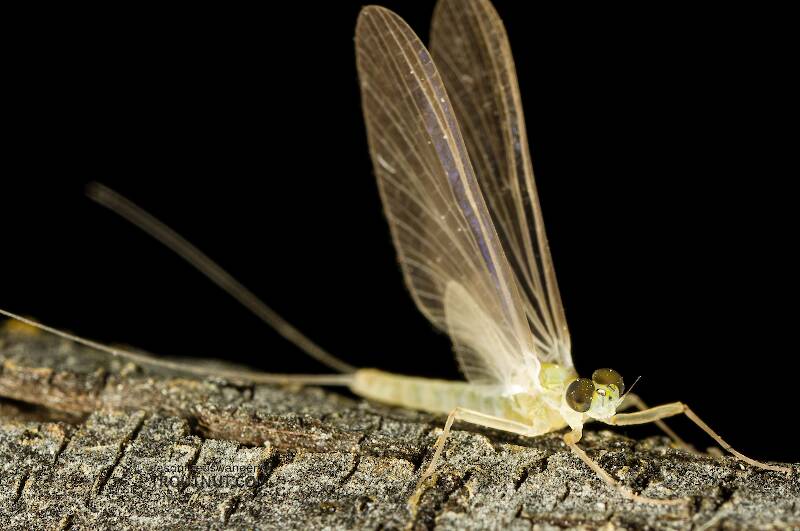
The lack of a darkened humeral crossvein rules out Epeorus albertae and Epeorus dulciana. The lack of a dark macula on the forefemora rules out Epeorus longimanus. The small size rules out Epeorus grandis and Epeorus permagnus. That leaves as the only possibility known in Washington state Epeorus deceptivus. It is a small species, although not reportedly quite as small as this specimen. I couldn't find anything in the species description in Traver (1935) to definitively confirm or rule out the species ID, given that I don't have the preserved specimen to check under a microscope, but it has to be either deceptivus or something not yet reported in Washington.
It was collected at the same time as a similar-sized female dun.
It was collected at the same time as a similar-sized female dun.
See 55 more specimens...
Mayfly Species Epeorus albertae
These are very rarely called Slate Cream Duns.
This is one of the two most common Western species of Epeorus, and its spinner falls can be important.

This specimen keys to the Epeorus albertae group of species. Of the five species in that group, the two known in Washington state are Epeorus albertae and Epeorus dulciana. Of the two, albertae has been collected in vastly more locations in Washington than dulciana, suggesting it is far more common. On that basis alone I'm tentatively putting this nymph in albertae, with the large caveat that there's no real information to rule out dulciana.
See 10 more specimens...
References
- Merritt R.W., Cummins, K.W., and Berg, M.B. 2019. An Introduction to the Aquatic Insects of North America (Fifth Edition). Kendall/Hunt Publishing Company.


